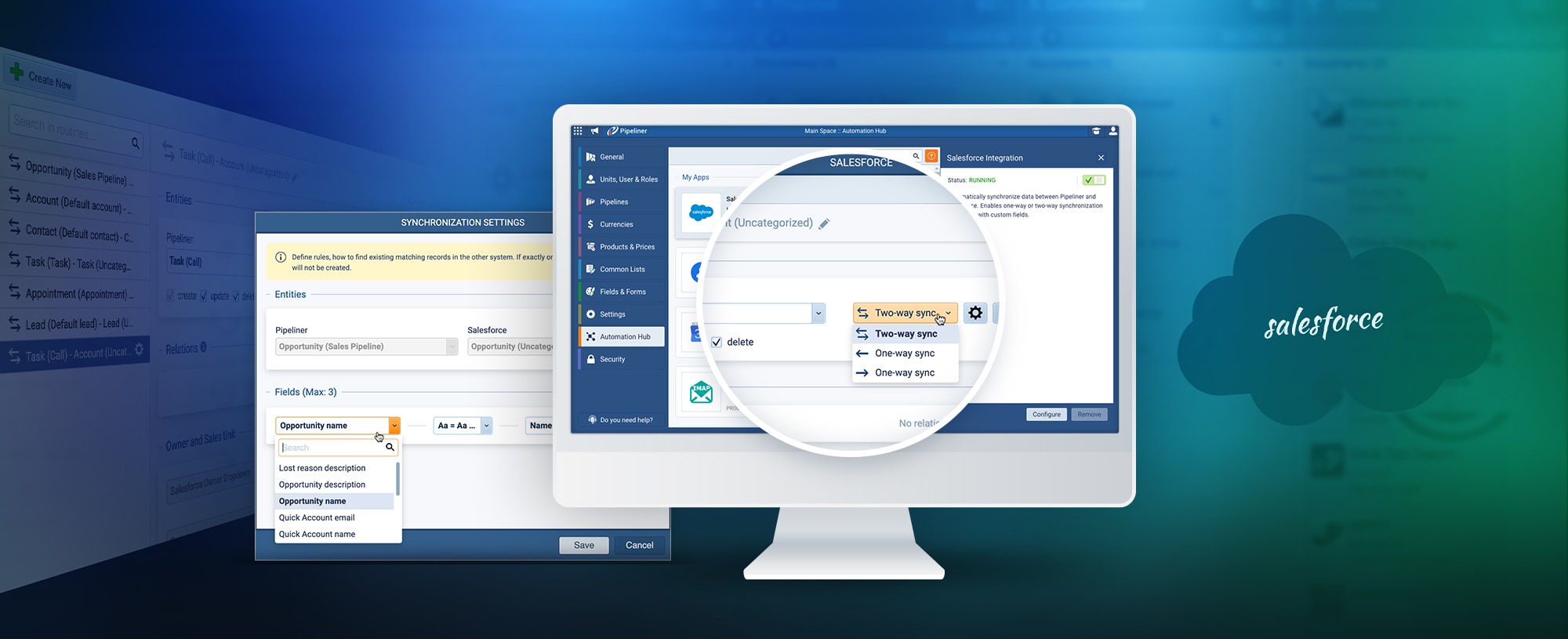Opportunity management could be said to be at the very heart of operating a sales pipelineSales Pipeline Sales Pipeline is a type of visualization showing the status of each sales prospect in the customer life cycle or sales process.. Opportunity management consists of, first, setting up a sales processSales Process Sales Process is a series of strategic steps or a set of activities aimed at driving sales growth through the alignment of personnel, market insight, methodologies, relevant business units, and technology.. This means knowing the various stages that your opportunities pass through, from leadLead Lead refers to a prospect or potential customer (who can be an individual or organization) that exhibits interest in your service or product; or any additional information about such entity. all the way to close. When you know how long a deal takes to make it through the pipelinePipeline Sales pipelineis a visual representation of the stage prospects are in the sales process., and how long it should take for an opportunity to make it through each stage of that pipeline, you’ve got a fairly accurate sales process.
But a sales process, to be accurate, must be dynamic. When you find flaws in the sales process, or changes happen in the marketplace necessitating changes to it, you need to be able to rapidly make those changes and keep right on doing business. Pipeliner CRM is flexible enough that you can instantly make such sales process changes when needed, and it requires very little training.
Visualization Means Effectiveness
One vital factor of opportunity management must be visualization. The easier it is for a sales manager to visually see the pipeline and opportunities, the more effective sales management will be.
Pipeliner takes visualization one major step further, however—to instant dynamic visualization. DataData Data is a set of quantitative and qualitative facts that can be used as reference or inputs for computations, analyses, descriptions, predictions, reasoning and planning. is being manipulated instantly and dynamically, by or right with the reps being managed. Data changed is immediately seen by anyone involved.
Pipeline CRM users are provided a number of different opportunity views, so that a salesperson or sales managerSales Manager Sales Manager is an executive who leads a sales unit, team or department by setting goals and meeting targets, formulating plans and policies, designating tasks, and developing salespeople. is able to choose which is best for them.
Filter View—the precise view you need can be provided through instantly filtered data. You can filter and view tasks based on any field. Views that will be regularly used can be saved.
Pipeline View—your sales process is graphically represented through the Pipeline View. From left to right, opportunities are shown within the sales process stages in which they currently reside. You can hover over them or click on them for further detail. The Pipeline View also applies to Pipeliner’s unique Archive, where lost deals are stored complete with all data.
Bubble Chart View—this is a totally unique opportunity map that includes 3 crucial dimensions: the sales process stage in which the deal resides, the estimated close date and the deal size.
Compact View—a view that allows you to, at a glance, see the last time a prospect was touched within CRM, sales opportunities that involve that prospect, and activity from their running feed (latest internal messages, social CRM updates or emails). Compact View can also be applied to opportunities, leads, accounts, contacts, and opportunities within the Archive, which is the place where lost deals can be viewed.
List View—totally customizable for your distinct requirements, the list view displays your leads, opportunities, accounts, contacts, or opportunities in a column/row format, totally customizable for your particular needs.
Highlight Changes in List View—this powerful feature allows you to see, within List View, changed opportunities within a userUser User means a person who uses or consumes a product or a service, usually a digital device or an online service.-specified period of time. Highlight opportunities that have been downgraded, updated or otherwise changed.
Map View—Where are your contacts, leads, accounts, and opportunities located? Find out with the map view—an interactive world map.
Calendar View—Appointments and tasks—by day, work week, week and month—are displayed with the Calendar View. On the right-hand panel is the Activity Stream, which displays upcoming and overdue appointments and tasks.
Task Board View—this view provides a display of tasks organized by activity status. The activity stream in the right-hand panel displays upcoming and overdue appointments and tasks.
Mouse Over View for Stages—this unique Pipeliner-only feature allows you to instantly view vital statistics for each stage, when you mouse over the stage. Immediately see, for that stage, Open Versus Lost, Loss Rate, Average Velocity (time opportunities have spent in that stage), and ConversionConversion Conversion is the process of turning a target consumer into a paying customer; or more generally, the point at which a user performs a specific action favorable to a marketer or a seller. Ratio to Next Step.
The Crucial Sales Target
In each of its phases, opportunity management should align with the sales target for that sales period. Pipeliner is also unique in this regard in that the target for the current sales period is always in view, and therefore always in mind for the sales team and sales manager. Any system should be geared around the target—what must be accomplished in any given time frame, be it a week, month, quarterQuarter Quarter is a three-month period in a company’s fiscal year commonly used to make comparative performance analyses, detect or forecast business trends, report earnings, and pay shareholder dividends., half-year or year.
For varying aspects of a target, five different target views are offered within Pipeliner CRM:
Unweighted Sales Target: This is the raw value of all opportunities lacking closing probability percentages. This can be useful if you have some historical data that says, for example, that a rep closes 10 percent of all opportunities. You would look for the Unweighted Sales Target to be at least 10 times the goal.
Weighted Sales Target: the sum of opportunity values within each sales stage, multiplied by the probability of closure for that sales process stage.
Ranked Target: A salesperson is enabled to apply a personal evaluation ranking of one to five stars to each of their opportunities. The Ranked Target shows their level of confidence in their opportunities.
Balanced Target: The Balanced Target balances the Ranked and Weighted Targets, so it can be seen as the “worst-case scenario.”
Real Target: Actual closed or won opportunities is represented by the Real Target.
Document Management
In a competitive sales environment, speed through the pipeline is an important aspect of opportunity management. In each pipeline stage, it often happens that documents or collateral must be attached to emails or otherwise provided to the clientClient A client is an entity who pays another entity for products purchased or services rendered. Also called a customer.. It’s a substantial benefit if a sales rep doesn’t have to go poking around outside CRM for a proposal or templateTemplate Template is a generic file with a framework showing the standard sections or features of a specific kind of document, used to create a new document of the same type faster and easier., since they’re right there one click away. Pipeliner offers this functionality—and in fact no other CRM system allows such simple and easy access for the attachment of documents in each stage.
Opportunity Follow-Up
So you can follow up opportunities, Pipeliner CRM enables you to send emails right from CRM to a group or single recipient, for Gmail or Office 365. You can utilize customized email templates, and quickly and easily add fields from Accounts, Contacts, Leads or Opportunities, as well as sender details.
Large Deal Approval Process
An approval process can be created within companies with large teams with routinely created big deals. It can be made mandatory that deals over a certain amount of potential revenueRevenue Revenue is the amount of money a business generates during a specific period such as a year or a quarter; also called sales. must be approved by management before they can proceed, and a process can be created that the deal must progress through before it can be moved forward. On the front end, the user will be notified that the deal has been locked for editing and is waiting for approval. The approval process allows the person responsible for approval to simply check boxes to approve, reject, delegate or cancel the deal. The salesperson responsible for the deal is then automatically notified of the deal approval status.
Central: War Room Concept
Pipeline management has, right at its heart, the War Room Concept. It was learned from IBM and rooted in their 40 years of experience with a similar approach (We will be going into more detail on this concept in the last chapter). Pipeliner’s Power Panel, which allows precise filtering of rep or team performance statistics, is the core functionality of the War Room Concept. Through the filter a sales manager can see if a specific deal is moving (sales velocity), what kind of ranking the sales manager gave it, and how it’s progressing. The sales manager can rapidly view this data before meeting with a particular rep about a deal.
The War Room Concept must be viewed by sales management from two different perspectives: deal management, and pipeline management. The two are often confused, and such a confusion can be a source of inefficiency when it comes to sales management.
Deal Management Perspective
Deal management is all about tracking specific deal progression, and deciding on and applying the activities required to move that particular deal to the next stage.
Failing to isolate prospect or buyerBuyer A buyer is an individual or organizational entity that purchases a product or subscribes to a service. issues relating to a service or productProduct Product refers to anything (an idea, item, service, process or information) that meets a need or a desire and is offered to a market, usually but not always at a price. being sold is a common salesperson error. The rep will consider that because a presentation or call seemed to go well, that the prospect is happy with the deal. The deal is at serious risk, though, when the salesperson doesn’t specifically know what problem their offering will solve for the client. If they haven’t isolated the need, they most likely haven’t checked the other three points besides need: budget, authority (does the decision-maker have the authority to make the purchase?), and timeframe (will this purchase be made within a reasonable amount of time?). A “feelgood” deal may be somewhat satisfying to the rep, but the rep won’t be able to move it to the next stage of the pipeline.
Deal management doesn’t always move a deal forward to the next stage. Sometimes a deal will actually move backward out of necessity. For example, as a sales rep you might be dealing with a parts buyer, who is almost to the point of closing, when that buyer is fired. A new buyer comes on and you are able to interest them—but you now must go back to stage 1, whereas your previous contact was already at stage 4.
From the back end, specific activities can be specified as having to be done before moving an activity from one stage to the next, and can even be mandatory. Checkboxes can also be required to be checked off before moving an opportunity forward. You can even specify automatic sequences to run for opportunities when they reach that particular stage, such as an email sequence, that must occur before moving to the next stage. On the front end, the seller can immediately view the required steps or automation steps in a particular stage, and (if allowed) can check or uncheck them for each individual opportunity. If a step is mandatory, the seller must check it before moving the opportunity forward. When a seller goes to move a deal to the next stage, they will be notified if all the required steps have been completed.
A seller, when working a specific opportunity, is able to instantly view all its details. These include products or services being sold, value, expected close data, ranking data, and more.
Deal management is fully empowered by Pipeliner CRM with completely unique features such as org chart, buying center, task and activity management, and more. A sales manager should have a very good overview of deals, and with these tools, they will. Additionally, the seller’s activity should always be in response to the buyer’s action as an opportunity moves through a sales stage—another unique Pipeliner feature. This functionality allows for a very tight opportunity concept that allows for all necessary activities such as appointments, calls, emails and more.
Full Pipeline Management
Deal management addresses single opportunities—but Pipeliner management takes into accountAccount Account refers to a record of primary and background information about an individual or corporate customer, including contact data, preferred services, and transactions with your company. all the deals in the pipeline, gauging their value, and whether or not there are enough of them. Meetings should be valuable meetings, and opportunities should be real opportunities, not leads mistaken for opportunities. Proper activity management, in which certain tasks must be completed before an opportunity can be moved to the next stage, is vital to effective pipeline management. Pipeliner CRM offers this as another of its totally unique features.
Does the rep have enough opportunities in their pipeline to make quotaQuota Quota is a predefined benchmark indicating the amount of sales a selling unit such as a sales rep or a regional sales team should achieve within a given period, often used as a measure of success, performance and eligibility for commissions and other rewards.? As an example, if the rep usually closes 3 out of 10 deals, and the quota is $50,000, there should be in the neighborhood of $180,000 worth of deals in the pipeline if the quota is going to be attained.
Salespeople are all different—with differing average deal sizes, closing ratios, and rates of opportunity movement. You have to act accordingly in managing each rep. One rep may need 5 times as many deals in a pipeline to make a quota than another.
All of these factors sum up to sales management. If they are not all present, then it isn’t sales management that’s being done. Instant pipeline visualization, which is what Pipeliner makes extremely easy, is what is needed for a sales manager to share data with the sales rep being managed. If a sales manager is only going over complex reports by himself, how can the sales rep be changed for the better?
Pipeliner, due to its visual characteristics, functions not only as a sales tool, but a psychological one. It influences a salesperson. They see their visual data and say, “Oh, my goodness!” From this visual approach it is much easier to come up with actions that will fill up a rep’s pipeline with more opportunities. If this isn’t done, they will never make it.
Deal and pipeline management are both easily conducted with Pipeliner. You can optimize them automatically—create reports and simply update them weekly. And wherever you go in Pipeliner, you can create an instant report based on the view at that moment.
Same Data Visible to Everyone
For the sake of transparency, as well as simplicity, data viewable by a sales rep is the exact same as seen by the sales manager. The only difference is that the sales manager can see data from all the other reps, whereas a sales rep can see only their own data. Transparency is the heart of great pipeline management.
What does all this mean? Precise, perfect opportunity management!





